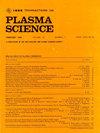大气压下热发射驱动氩微弧放电动力学特性的数值模拟
IF 1.3
4区 物理与天体物理
Q3 PHYSICS, FLUIDS & PLASMAS
引用次数: 0
摘要
最近的研究表明,阴极的热发射在微弧放电的基础研究中起着至关重要的作用。本文采用一维隐式粒子入室耦合蒙特卡罗碰撞(PIC-MCC)方法模拟了大气压下的热发射驱动微弧放电。应用两种热发射模型--热离子发射(TE)模型和热场发射(TFE)模型,对比分析了热微等离子体的粒子输运现象。考虑到阴极附近的局部电场会影响电流密度,而电离可以产生足够的空间电荷来改变电场,因此在不同条件下,包括阴极温度(${T} _{text {C}} = 2500~\sim ~3500$ K)、外加电压(${U} = 1~\sim ~30$ V)和间隙大小(${d} = 10~\sim ~100~\mu $ m),对阴极的不同电流密度及其对总电流密度的贡献进行了评估。同时还考察了带电粒子的电场、最大数量密度和空间平均温度,以研究热发射和放电物理之间的相互作用。此外,还分析了二次电子发射的影响,以准确预测微弧放电中的电子发射。结果表明,随着间隙减小、阴极温度升高以及场发射(FE)增强导致的外加电压升高,TE 和 TFE 产生的热微等离子体之间的差异会变得更加明显。此外,由于离子增强效应,两种发射模式的气体击穿发生在相对较低的 17 V 电压下。由于电子碰撞平均自由路径和间隙大小之间的差异,阴极的电流密度在 ${d} = 30~\mu $ m 时达到最大值。此外,阴极温度越高,二次电子发射系数越大,二次电子发射越明显。本文章由计算机程序翻译,如有差异,请以英文原文为准。
Numerical Simulation of Kinetic Characteristics of Thermal Emission-Driven Argon Microarc Discharge at Atmospheric Pressure
Recent studies have shown that the thermal emission from the cathode plays a crucial role in the basic research on microarc discharge. In this work, a 1-D implicit particle-in-cell coupled with the Monte Carlo collision (PIC-MCC) method is adopted to simulate thermal emission-driven microarc discharge at atmospheric pressure. Two thermal emission models—thermionic emission (TE) model and thermofield emission (TFE) model—are applied to contrast and analyze the particle transport phenomena of thermal microplasma. Considering that the local electric field near the cathode affects the current densities and ionization can create sufficient space charge to modify the electric field, different current densities at the cathode and their contribution to the total current densities are evaluated under various conditions, including cathode temperatures (
${T} _{\text {C}} = 2500~\sim ~3500$
K), applied voltages (
${U} = 1~\sim ~30$
V), and gap sizes (
${d} = 10~\sim ~100~\mu $
m). The electric field, maximum number density, and spatially averaged temperature of charged particles are also examined to study the interaction between thermal emission and discharge physics. Furthermore, the effects of secondary electron emission are analyzed to accurately predict electron emission in the microarc discharge. The results indicate the difference between thermal microplasma generated by TE and TFE becomes more pronounced as the gap size decreases, the cathode temperature increases, and the applied voltage increases due to the enhanced field emission (FE). In addition, gas breakdown occurs at a relatively lower voltage of 17 V for the two emission models because of the ion-enhancement effect. There exists a maximum at
${d} = 30~\mu $
m in current density at the cathode due to the difference between collision mean free path of electron and gap sizes. Besides, the secondary electron emission becomes more pronounced at higher cathode temperatures and larger secondary electron emission coefficients.
求助全文
通过发布文献求助,成功后即可免费获取论文全文。
去求助
来源期刊

IEEE Transactions on Plasma Science
物理-物理:流体与等离子体
CiteScore
3.00
自引率
20.00%
发文量
538
审稿时长
3.8 months
期刊介绍:
The scope covers all aspects of the theory and application of plasma science. It includes the following areas: magnetohydrodynamics; thermionics and plasma diodes; basic plasma phenomena; gaseous electronics; microwave/plasma interaction; electron, ion, and plasma sources; space plasmas; intense electron and ion beams; laser-plasma interactions; plasma diagnostics; plasma chemistry and processing; solid-state plasmas; plasma heating; plasma for controlled fusion research; high energy density plasmas; industrial/commercial applications of plasma physics; plasma waves and instabilities; and high power microwave and submillimeter wave generation.
 求助内容:
求助内容: 应助结果提醒方式:
应助结果提醒方式:


